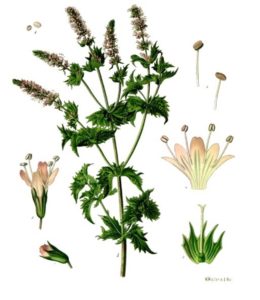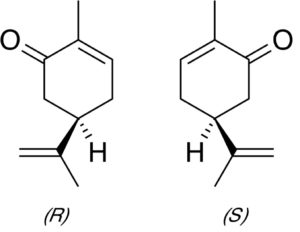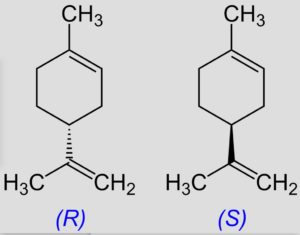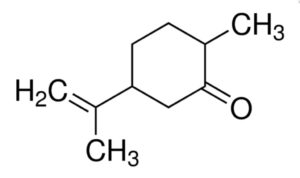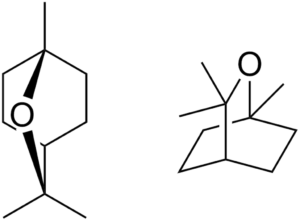— This article by Jerry Cates was first published on 18 April 2016, and revised last on 11 September 2016. © Budsinthenews Vol. 7:4(1).
Spearmint, also spelled as two words, i.e., spear mint — is named for its pointed leaf tips, and is native to much of Europe and Asia. It is now cultivated throughout the world. A herbaceous perennial, it grows from 30–100 cm tall above ground, with wide-spreading fleshy underground rhizomes. Leaves have serrated margins and measure 5–9 cm in length and 1.5–3 cm wide. As with all members of the mint family, the stem has a square cross-section. Its flowers form slender spikes, with each white or pink flower measuring 2.5–3 mm in length.
Spearmint readily forms hybrids with watermint (M. aquatica) [ Mentha × piperita = peppermint], with wild or corn mint (M. arvensis) [Mentha × gracilis = ginger mint], and with apple mint (M. suaveolens) [Mentha × villosa = large apple mint].
A hardy plant, spearmint prefers loamy soils rich in organic matter, in partial shade. It grows well, however, in full sun and in shady spots throughout most temperate climes. Gardeners usually confine it to pots or planters to keep its aggressive rhizomes under control.
Spearmint leaves, which when properly collected can be used fresh, dried, or frozen, lose their aromatic appeal after the plant flowers. Experienced collectors dry the leaves by cutting just before, or immediately upon the opening of the flowers, when the leaf aromatics are at their peak of concentration. Cuts are made one-half to three-quarters of the distance down the stalk so as to permit smaller shoots room to grow.
Spearmint is famous for its aromatic spearmint oil, whose most abundant constituent, R-(–)-carvone (60-70%), is responsible for its distinctive fragrance. Spearmint oil also contains R-(-)-limonene (13-20%), (1)-dihydrocarvone (3-5%), and eucalyptol [1,8-cineol] (3-5%), β-pinene (2-3%), trans-Dihydrocarvyl acetate (1-2%), and cis-Carvyl acetate (1-2%), but — unlike oil extracted from its hybrid with water mint, peppermint — spearmint has only minimal amounts of menthol and menthone.
Essential oil research has shown spearmint oil to possess significant antifungal activity. It has been used with some success against food poisoning pathogens. The Ames test, which uses bacteria to determine whether specific chemicals cause mutations in the bacteria’s DNA, indicates spearmint oil is not mutagenic.
R-(–)-carvone
Though spearmint extracts contain only one form of carvone, specifically the righ-thanded enantiomer R-(-)-carvone, a discussion on that form of carvone, alone, would only tell half of the story. Carvone, the name of the generic molecule, undifferentiated in terms of its two enantiomers, exists in nature in two distinct forms, and humans perceive each of those forms differently.
More about that below, but first, note that carvone is a terpenoid (also known as an isoprenoid). Terpenoids are a subclass of the prenyllipids (terpenes, prenylquinones, and sterols); they represent the oldest group of small molecular products synthesized by plants and are probably the most widespread group of natural chemicals produced by plants. Carvone is found naturally in many essential oils, and most abundantly in oils extracted from caraway (Carum carvi) seeds, spearmint (Mentha spicata) herb, and dill (Anethum graveolens) herb. The latter, though like the mints is an asterid, is not in the mint family (Lamiaceae), but is instead a member of the celery family (Apiaceae).
As alluded to earlier, the carvone molecule is arranged structurally in two mirror-image forms or enantiomers: R-(–)-carvone, the right-handed form, is what imparts to spearmint leaves their unique odor. Carvone’s left-handed mirror image, S-(+)-carvone, imparts the less unique odor possessed by caraway seeds and dill. The fact that the human olfactory sense distinguishes between these two enantiomers proves that human olfactory receptors have chiral groups that allow them to respond more strongly to one enantiomer than to the other. Not all enantiomers have distinguishable odors, and not all animals have chiral groups in their olfactory organs, but it is known that squirrel monkeys, like humans, are able to discriminate between the two carvone enantiomers.
Limonene
Like carvone, limonene is a chiral molecule with two enantiomers. D-limonene, the right-handed enantiomer, is one of the most common terpenes in nature, and is responsible for the fragrance imparted in oranges. The left-handed enantiomer, S-limonene, is responsible for the fragrance imparted in lemons. Both enantiomers are considered to exhibit low mammalian toxicity.
In tests for carcinogenicity in mice and rats, initial results showed d-limonene increased the incidence of renal tubular tumors in male rats, though female rats and mice of both genders showed none. Later studies established that d-limonene does not pose a mutagenic, carcinogenic, or nephrotoxic risk to humans.
In humans, d-limonene has demonstrated low toxicity after single and repeated dosing for up to one year. As a solvent of cholesterol, d-limonene is capable of dissolving cholesterol-containing gallstones. As a gastric acid neutralizer, and because it supports normal peristalsis, it provides relief from heartburn and aids in reducing or eliminating gastroesophageal reflux (GERD). D-limonene also exhibits chemopreventive effects against a number of cancerous tumors.
Dihydrocarvone
As can be seen from its chemical structure, dihydrocarvone, carvone, and limonene are remarkably similar. It is not surprising, therefore, that all three share a number of traits that impact human biology.
In a study published in 2009 (Patil et al.), when extracts of Key Lime (Citrus x aurantifolia) were analyzed for their essential oil constituents, they were found to contain 30.47% D-dihydrocarvone and 30.13% D-limonene. The oil was then tested against human colon cancer cells and showed 78% inhibition of those cells when placed in a 100 μg/ml concentration for 48 h. Further tests suggested that lime volatile oil has potential benefits in colon cancer prevention.
Eucalyptol [1,8-cineol]
Eucalyptol, a natural organic compound that in isolation forms a colorless liquid, is a cyclic ether and a monoterpenoid first described by F. S. Cloez in 1870, who found it to be the dominant fraction of oils extracted from the blue gum tree (Eucalyptus globulus). It is variously known as 1,8-cineol, 1,8-cineole, cajeputol, 1,8-epoxy-p-menthane, 1,8-oxido-p-menthane, eucalyptol, eucalyptole, 1,3,3-trimethyl-2-oxabicyclo[2,2,2]octane, cineol, and cineole.
Though In higher-than-normal doses, eucalyptol is hazardous via ingestion, skin contact, or inhalation, can have acute health effects on behavior, respiratory tract, and nervous system, is classified as a reproductive toxin for females and is a suspected reproductive toxin for males, eucalyptol has a number of important medicinal properties. In addition, it is often used as an ingredient in insecticides and insect repellents.
Eucalyptol is one of several compounds that attract males of various species of orchid bees. For this reason it is commonly used as bait to attract and collect such bees for study. For example, it has been shown that males of Euglossa imperialis, a non-social orchid bee, are attracted by eucalyptol, and in its presence exhibit exaggerated territorial behavior. These males were found to periodically leave their territories to forage for chemicals such as eucalyptol, which are used to synthesize sociochemicals, or pheromones, that attract females of the species.
Though eucalyptol comprises over 90% of the oils extracted from certain species of eucalyptus, in spearmint oil it constitutes only 3-5% of the total.
Taxonomy:
- Domain: Eukaryota (yew-carr-ee-OH-tah) — from the Greek prefix ευ (yew) = good, well, pleasing + καρυον (khar-yone) = a nut/nucleus, thus organisms whose cells contain a nucleus and other organelles within membranes.
- (unranked): Bikonta Cavalier-Smith, 1993 (bye-KOHN-tuh) — from the Latin bis = twice/double + the Greek κοντος = a punting pole; those eukaryotic organisms within the subgroups Apusozoa, Rhizaria, Excavata, Archaeplastida, or Chromalveolata.
- (unranked): Archaeplastida Adl et al., 2005 (ahr-kee-PLASS-tih-duh) — from the Greek αρχαιος (AHR-kee-ose) = ancient/antiquated + πλασις (PLAS-iss) = a moulding + Anglo Saxon tid = time; a major group of eukaryotes, comprised of the red algae (Rhodophyta), the green algae, and the land plants along with the freshwater unicellular algae known as glaucophytes.
- Kingdom/Regnum: Plantae Copeland, 1956 (PLAN-tee) or Viridiplantae Cavalier-Smith, 1881 (veer-id-eye-PLAN-tee) — from the Latin planta = a green twig; the plant kingdom, consisting of multi-cellular green plants, i.e., whose cells have cellulose within their cell walls and have primary chloroplasts derived from endosymbiosis with cyanobacteria containing chlorophylls a and b and lack phycobilins..
- (unranked): Streptophyta Jeffrey 1967 (strepp-toh-PHY-tuh) — from στρεπτος (STREP-tose) = (easily) twisted, pliant + φυτον (PHU-tawn) = a plant/tree; the land plants and the green algal group Charophyta.
- Subkingdom: Embryophyta Engler, 1892 (imm-bree-oh-FYE-tuh) — from the Greek εμβρυον (EMM-bree-yon) + φυτον (PHU-tawn) = a plant/tree; green plants, informally known as land plants because most are terrestrial rather than aquatic, while the related green algae are primarily aquatic;
- (unranked): Angiosperms (AN-gee-oh-spurms)/Magnoliophyta Cronquist (mag-NOH-lee-oh-fye-tuh) — from the Greek αγγειον (AUGG-ee-awn) = a vessel/pail/reservoir + σπερμα (SPUR-mah) = a seed; the flowering plants, distinguished from the gymnosperms by having flowers, endosperm within the seeds, and the production of fruits that contain the seeds;
- (unranked) Eudicots (YEW-dee-kotts) — from the Greek prefix ευ (yew) = good, well, pleasing + δι (die/dee) = two/double + κοτυληδων (cott-ee-LEE-dun) = a cup-shaped hollow; a monophyletic clade of flowering plants previously known as tricolpates or non-magnoliid dicots, to emphasize the evolutionary divergence of tricolpat dicots from earlier, less specialized dicots; close relationships are presumed among flowering plants with tricolpate pollen grains (the grains have three colpi, or elongated apertures or furrows in the pollen grain paralleling the polar axis);
- (unranked) Asterids (ASS-tur-iddz) — from the Greek αστηρ (ASS-turr) = a star/meteor + the Latin suffix -idus (EE-duss) = indicative of having the nature of; one of the two most species group of eudicots (which have inflorescences having the appearance of a meteor or shooting star), the other being the rosids;
- Order: Lamiales (lam-ee-AWL-ees) — the etymology of this designation is obscure; comprised of asterids generally having a superior ovary composed of two fused carpels, inflorescences with four petals fused into a tube, bilaterally symmetrical, often bilabial corollas, and four or fewer fertile stamens;
- Family: Lamiaceae (lam-ee-ACE-uh-ee) — the etymology of this designation is obscure; comprised of the mint or deadnettle family of flowering plants containing about 236 genera and some 6,900 to 7,534 species, many aromatic in all parts, others being shrubs, trees (incl. teak), and some vines;
- Subfamily: Nepetoideae (nepp-uh-TOY-duh-ee) — from the Latin noun nepeta = catnip, a kind of mint; a subfamily of the mint family divided into four tribes: 1. Tribe Elsholtzieae, 2. Tribe Lavanduleae (includes lavender), 3. Tribe Mentheae (the largest tribe, containing the herbs sage, thyme, and mint), and 4. Tribe Ocimeae (includes sweet basil);
- Tribe: Mentheae (MEN-thay-ee) — from the Latin noun menthe = mint; comprised of one third of the species of the mint family, Lamiaceae; common names of plants within this tribe are apple-mint, corn-mint, ginger mint, horsemint, mint, orange-mint, pennyroyal, peppermint, spearmint, and watermint;
- Genus: Mentha L. — from the Latin mentha/menta = mint; a genus of aromatic, almost exclusively perennial herbs with wide spreading underground stolons and branched erect, square, stems, comprised of 13-18 recognized species, none clearly distinct, many of which hybridize naturally; many hybrids and cultivars are in cultivation;
- Species: M. spicata L. — commonly known as spearmint; a species native to Europe and Asia, and naturalized in Africa, the Americas, and the oceanic islands; a herbaceos, rhizomatous perennial mint with pink or white flowers in slender spikes;
References: In process… we do not post references that are not in our at-hand library and that we have not thoroughly examined. The vetting process takes time. A list of appropriate references relevant to the matter presented in this article will be posted as they become available.
- Patil, Jaiprakash R. et al. 2009. Apoptosis-mediated proliferation inhibition of human colon cancer cells by volatile principles of Citrus aurantifolia. Food Chemistry 114 (2009) 1351–1358
— Feel free to e-mail jerry.cates@entomobiotics.com regarding your comments on this article. You may also register, log in, and leave a detailed comment in the space provided below.
